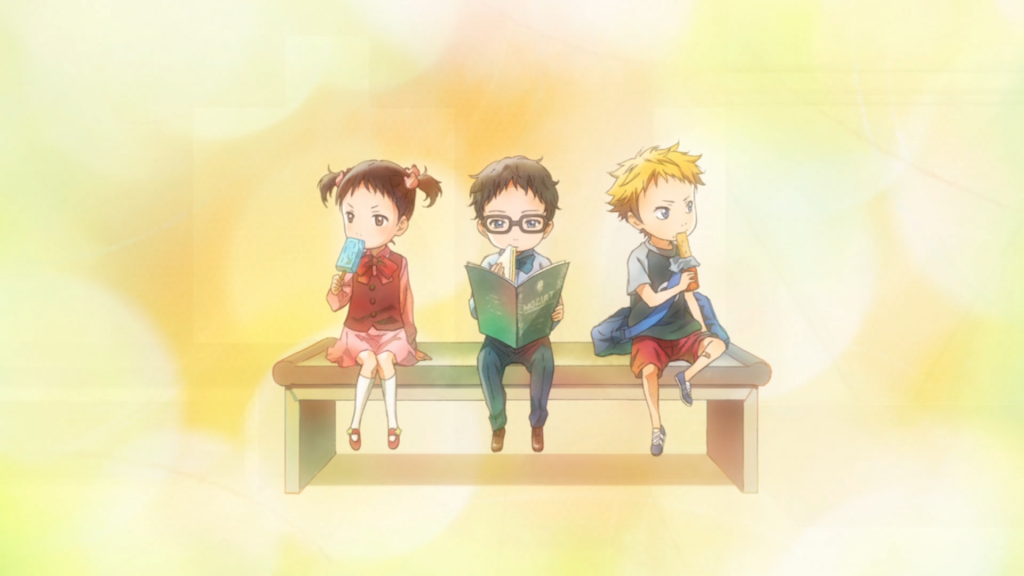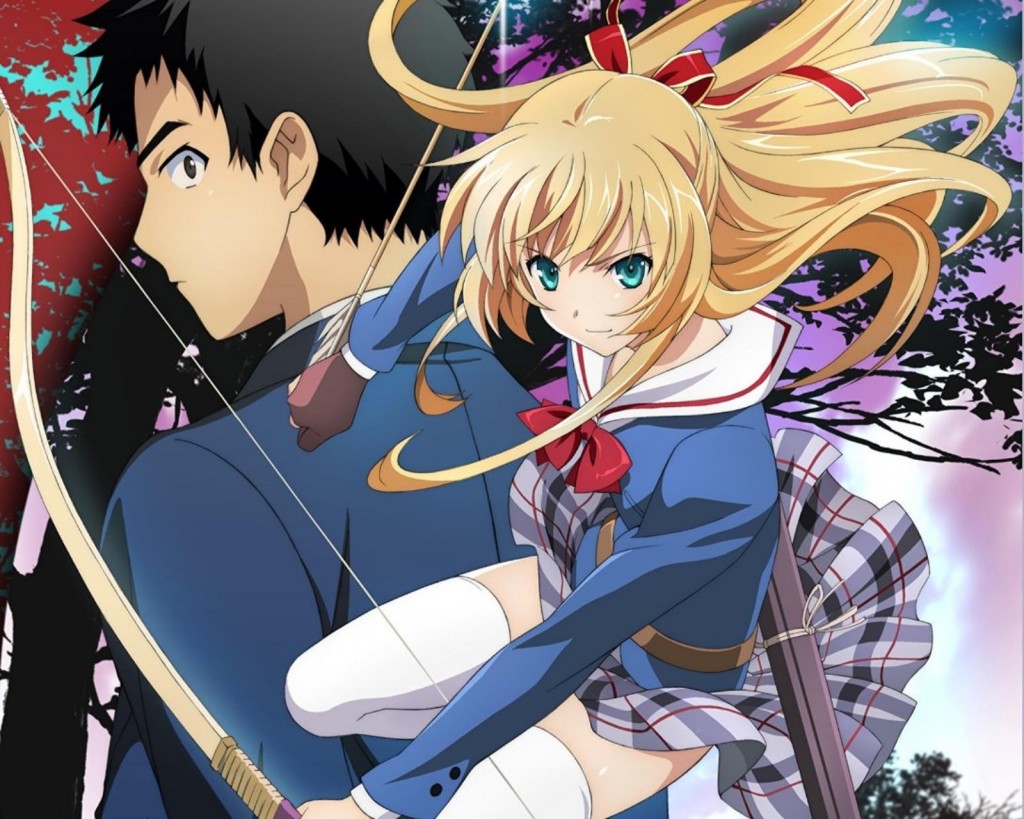January 21st, 2016 in Anime, General Reviews, High School DxD BorN by The Droid

Look, there HAD to be another season of “DxD”, as so much was left hanging out there (and I don’t mean all the naked boobies, and there are a lot of those!) But this season, called “High School DxD BorN” (and why it is done that way, I do not know. I can’t find rhyme nor reason for it) felt like treading water.
It is summer break at the school, but as we know, there is no rest for the wicked. The Occult Research Club members are going on a trip to the underworld. Man, I said DISNEY World (You have got to enunciate!) Aside from gaining valuable training experience and expertise, it gives the members a real chance to bond, as we have added a few more to the chessboard. However, it’s not going to be all fire and brimstone, as Loki and the Chaos Brigade show up and do what their name intends. The series contends itself with trying to keep the team together while battling seemingly overwhelming odds against implacable foes, bent on, at least, personal destruction. And naked boobies. (more…)
Tags: Action, Comedy, Demons, Ecchi, Harem, Romance, School
January 17th, 2016 in Anime, Appleseed XIII, General Reviews, Uncategorized by The Droid

Yes, I know this was a movie, but, for me, like “Ghost in the Shell”, the series made more sense than the film, although that’s where the similarities with “Appleseed XIII” end.
It is the future (and with what I see, it had pretty well damn be). It is also after the close of WWV (No, not some Super Bowl; World War Five). On the plus side, it was fought with non-nuclear weaponry. On the negative side, about half the world’s population died. Well, at least I can get a parking space. We have also seen the rise of the city-state of Olympus, a gleaming spire offering a way out of the chaos and destruction of the past and into a grand and glorious future. Or not.
It is governed by Gaia, an artificial intelligence, and administered by bioroids, genetically engineered humans. Isn’t that eugenics? Just askin’!
Into this mix we have the battle duo of Deunan Knute, a young female special agent, and Briareos, a veteran cyborg soldier. They are partners and, when Briareos was human, perhaps lovers, (this is hinted at but never really defined). They work in E.S.W.A.T., the elite Special Forces serving Olympus. They are deployed wherever trouble strikes. Conspiracies, terrorism, deadly military weapons technology, greedy corporations, and power-hungry politicians, whenever it rises its ugly head, they are there to strike a blow for the future as they fight to protect Olympus and conduct their personal quest to find Eden in the wasteland. (Enter patriotic music beneath). (more…)
Tags: Action, Mecha, Military, Police, Sci-Fi
January 10th, 2016 in Anime, General Reviews, Le Labyrinthe de la Grisaia by The Droid

This is the second installment of the “Grisaia” Trilogy, noted as “Le Labyrinthe de la Grisaia”. Although presented as a ‘movie’, it is more like two extended episodes of the series and acts as a bridge piece between the ending of “Fruit” and the start of “Eden”, which will then conclude the entire series (in theory. You know how a cash cow is).
It is best seen as a recap/backstory approach, for we can examine how Yuuji became the rather cold-blooded killer that he is now. It is delivered as a report to his handler, JB, whom, I would have assumed, knew a lot more about him than the arc lets on. Or perhaps it is a reiteration of what she already knows and needs to know more and it benefits us in the long-run. What you come away with is that Yuuji is more morally bankrupt that you realize, more emotionally bereft that he lets on, more spiritually dead than he will actively admit to himself, but in the field of work that he finds himself, that is a marvelous asset. You shouldn’t be rationalizing things too much. We start out with his youth and his sister, Kazuki. (more…)
Tags: Drama
January 7th, 2016 in Anime, Cardcaptor Sakura, General Reviews by The Droid

Now, I have never seen anything regarding “Cardcaptor Sakura”, although I am aware that it is a CLAMP project, so that means it fits in to the other CLAMP worlds and that this Sakura is somehow related to the Sakura from “Tsubasa Chronicles”. (No, that’s OK; you do not have to outline the universe for me. It would probably wash over me, anyway.) I did want to see if I could watch this movie (“Cardcaptor Sakura: The Movie”, “Gekijōban Kādokyaputā Sakura”) with little to no understanding as to what it is about or what it all means. At best, it was a partial victory.
We open the film with Sakura Kinimoto, struggling to capture the Arrow Card, which she is able to seal, with a little help from her friends. That night, she has a strange dream about these ribbons that bind her and take her to see a very elegant Chinese lady (that is the woman up there and, yes, she is a degree of displeased). Sakura then magically wins a Winter Break trip to Hong Kong and she takes along Tomoyo Daidouji, her best friend and support team, her worthless brother Toya and his best friend Yukito Tsukishiro (whom Sakura has a crush on). Also coming along for the ride is Sakura’s guardian, Kero-chan (hanging on Sakura’s shoulder) and he is more than he seems, but for the film, he’s in that form. (more…)
Tags: Adventure, Comedy, Drama, Fantasy, Magic, Romance, School, Shoujo
January 3rd, 2016 in Anime, General Reviews, The Princess and the Pilot by The Droid

I did catch part of this at Fanime!, not realizing that “The Princess and the Pilot” (“To Aru Hikūshi e no Tsuioku”, “Recollections for a Certain Pilot”) was NOT “The Pilot’s Love Song”, even though both have the same general idea (and some theorize it is set in the same universe). I had to track it down later on, as I saw the bottom half and I needed the first part to understand what it was all about. You can try and piece things together from the second half and you could get the whole thing wrong. When I had a lumpy chance to see it (I caught it on a site that broke it up into four segments), I went for it.
It is an alternate universe, although the planes imply something late 30s to early 40s (if we used our calendar). What skews the ideas are these massive aircraft, which have a series of double propeller engines that generate 1.21 gigawatts of power to keep them aloft. The ships are huge, about the size of Delaware, yet these comparatively puny engines have them sailing along, singing a song. And how fast do they move? It looks like a tree could outrun them. Anyway, the country of San Maltilia is hosting a party for Prince Carlo, the next ruler of the Levamme Empire. He is awaiting the presentation of Lady Juana del Moral, who would be next in line for the throne. Her father, King Diego (whom my daughter thought looked like Gary Busey. Don’t be sticking a seashell in her ear, now!) wants this to go well, as these upcoming nuptials will strengthen relationships between these two nations, and make the del Morels a more powerful family. (more…)
Tags: Adventure, Military, Romance
December 31st, 2015 in Anime, General Reviews, Your Lie in April by The Droid

Just after “Your Lie in April” concluded, out came their OVA. This is a rare OVA, in that you have to see the series all the way through before you can honestly watch the OVA. The entire OVA is referenced throughout the series and it makes a caliber of sense when you see this, as you were given all the clues. I am assuming it is about four years earlier, so everyone is 10 or so, although the picture may give an indication of being eight. It’s hard to tell. We have the three main players on that bench, each noshing on their favorite treat.
Left to right, Emi Igawa, Kosei Arima and Takeshi Aiza, are all the same age and are all tremendously gifted pianists, but everyone takes a back seat to what Arima does. He is the Human Metronome, in that he plays the music perfectly. There isn’t much color or spark in what he does (unlike his rivals), but the judges look for technical perfection and Arima has that in spades. Here’s the funny thing: Arima is in competition against himself, trying to win over the love of his dying mother, who is as rough as they get. Emi and Aiza are chasing Arima and always coming up short. For the most part, there are your medalists, so to speak, as the rest of the competitors are left with scraps. (more…)
Tags: Drama, Music, Romance, School, Shounen
December 29th, 2015 in Anime, General Reviews, Kantai Collection by The Droid

This is another in the “Girls Who Save the World” genre, but, potentially, taken to the zenith of the idea. Also, sharing a lot with shows like “Upotte” and “Strike Witches”, “Kantai Collection” (also known as “Combined Fleet Girls Collection” and the nickname “Kancolle”) really goes all out with things.
In this Alternative Universe, although there is a World War going on, it is not fought with the other peoples of earth, but an alien group, bent on World Domination. “We will control all the Fun Size Snickers bars, so there!” Hahahahahahahahaha…………ahem! We are fighting on the high seas with girls who are battleships. By the style of ship and airplane, as well as off-duty garb, I would put this somewhere between 1938 and 1941 (if we were using a real calendar). Our heroine Fubuki (brown hair, second from right. It was hard to find a group shot of most of them that could be easily comprehended as to what was going on that wasn’t also smut smack) has been asked to join the task fleet. She is a destroyer, but we have all grades of ships: torpedo boats, aircraft carriers, communication ships, battle cruisers. (more…)
Tags: Action, Military, School, Sci-Fi, Slice of Life
December 13th, 2015 in Anime, General Reviews, Gurren Lagann by The Droid

I guess I should get around to this show; after all, it is #4 on my fan service list. “Gurren Lagann”, known in Japan as “Tengen Toppa Gurren Lagann” (“Pierce the Heavens, Gurren Lagann”) is a giant fighting robot show, but it is done differently than most GFRs, so I personally was able to tolerate a bit better, despite some pacing problems. But let’s get down to brass tacks, eh?
We are on Earth. Well, I assume it’s Earth. Does it matter? But we aren’t ON Earth; rather, underneath it. Simon (but pronounce it as ‘Simone’, he’s front and center) is a digger and may be the best one that they have in our underground enclave. He dreams of a better life, but he ain’t gonna get it. Stick to your drill, boy. He is befriended by Kamina (Mr Flashy up there in the Oakley or Maui Jim or Ray-Ban shades), who needs people to recruit into his dream of visiting the surface world. Oh, you should hear the guffaws around that one! One day, Simon finds a drill-shaped key. Well, it’s cute, so he hangs onto it. (You can just see it under his crossed arms). (more…)
Tags: Action, Comedy, Mecha, Sci-Fi
December 10th, 2015 in Anime, General Reviews, Isuca by The Droid

Yeah, this is another “Girls Who Save the World” anime, but the operative word here is ‘save’. I’ll explain “Isuca” as we go along.
We start off with Shinichirō Asano. To the entire world, he appears to be your typical anime high school male: just a tad on the clueless side. He follows some woman down a darkened street or alleyway or another caliber of pedestrian pathway. She then turns into a gigantic soul-sucking centipede or some other ilk of icky bug (please, keep your comments to yourself about women until the end, OK?) He is saved by a bow-wielding archer that cuts down said bug woman in nothing flat. This woman is Sakuya Shimazu, a well-liked classmate. We also learn that she is destined to be the 37th head of the Shimazu family, who, for generations, have been sealing away youmas and other nasties that crawl in the night (but no politicians. Drat, but you can’t have it all).
It is decided (not by either of them) that he is to move in with her and basically run the household. You see, Sakuya does not play well with others, can’t figure out which end of a frying pan to use and needs all the help she can get. Shinichiro needs a job and there you have it. The series contends itself with several storylines: Sakuya’s struggle to be the next head of the family while learning her skills, how helpful Shinichiro can/will/is going to be to her and himself and how they both/all deal with the very mysterious Isuca, a force to be reckoned with. (more…)
Tags: Action, Comedy, Ecchi, Romance, School, Seinen, Supernatural
December 6th, 2015 in Anime, General Reviews, Your Lie in April by The Droid

I actually had a chance to view this about six months earlier, but the capsule description seemed a bit uncertain and I’m not a fan of music shows. I find they are in the area of sports shows, where we end up focusing too much on the performance and the show loses something about the people. But then I heard that this was a really romantic series, the best in the past few years. On Free Comic Book Day, one of the offerings was a manga sampler, of which the first chapter of this tale was shown. Well, with all these promotions, I had to see it.
The show is “Your Lie in April”, known in Japan as “Shigatsu wa Kimi no Uso” (“April is Your Lie”) and tells the story of piano prodigy Kousei Arima (glasses up there). He dominated the world of piano competitions and became famous among child musicians. His mother, who was also his instructor, was a very tough taskmaster. She died and he had a mental breakdown while performing at a piano recital at the age of eleven. As a result, he was/is no longer able to hear the sound of his piano even though his hearing is perfectly fine, and he completely disappeared from the scene. (more…)
Tags: Drama, Music, Romance, School, Shounen









